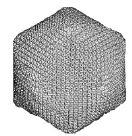Plant Pathology, Department of

James Van Etten Publications
Document Type
Article
Date of this Version
2019
Citation
Journal of Virology
doi:10.1128/JVI.01688-18
Abstract
Chloroviruses exist in aquatic systems around the planet where they infect certain eukaryotic green algae that are mutualistic endosymbionts in a variety of protists and metazoans. Natural chlorovirus populations are seasonally dynamic but the precise temporal changes in these populations and the mechanisms that underlie them have, heretofore, been unclear. We recently reported the novel concept that predator/prey-mediated virus activation regulates chlorovirus population dynamics, and in the current manuscript demonstrate virus packaged chemotactic modulation of prey behavior.
Viruses have not previously been reported to act as chemotactic/chemo-attractive agents. Rather, viruses as extracellular entities are generally viewed as non-metabolically active spore-like agents that await further infection events upon collisions with appropriate host cells. That a virus might actively contribute to its fate via chemotaxis and change the behavior of an organism independent of infection is unprecedented.


Comments
Copyright © 2019 American Society for Microbiology. Used by permission.